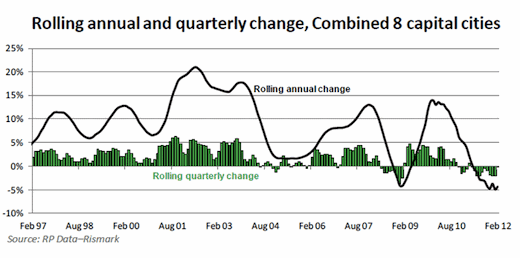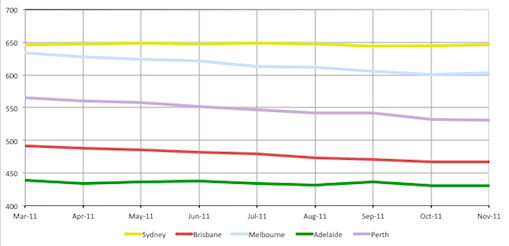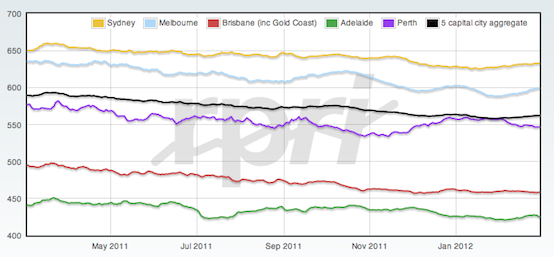
Given that RPData gave the housing market a little shock yesterday with the launch of their new daily index it appears that there is no data for January to report. In fact it appears to have received barely a passing mention in most media reports:
Melbourne led a rebound in capital city dwelling prices in February, with the Victorian capital recording 1.8% growth for the month, according to the new RP Data-Rismark Daily Home Value Index.
On a rolling quarterly basis during the three months ending February 2012, Australian capital city home values fell 0.2%.
Based on the new daily index, this was the best quarterly reading since the three-month period ending March 2011.
RP Data head of research Tim Lawless says the results in February suggest the decline in house prices has been easing though he does not believe the November and December rate cuts were enough to drive back growth into the housing market.
Given we suddenly appear to be in a “cross over” period I thought I would attempt to bridge the gap between RPData’s old index, which MacroBusiness previously reported on monthly, with what appears to be the product offering going forward. That is, their new daily index.
From the article above, a 1.8% jump in Victoria for a month does sound impressive, but once you see the longer term chart for the new index you start to understand Tim Lawless’s take on the data:
There is certainly no doubt about the recent trend, and Mr lawless is right to be wary about calling a bottom based on that chart. If you take a very long view of RPData’s data you start to get an idea of how unusual the recent slump is in the context of the last 15 years.

I actually rang RPData yesterday to get some additional information, most notably how the new index will deal with revisions, something that was very important in their previous monthly index, and secondly how exactly the new “monthly” index will be derived. I was informed that the monthly index will simply be the MoM change of the daily index and that there will be no revisions under the new methodology (described here). This seems obvious once you realise the index is already on the ASX website in preparation for it to be a tradable index on a daily basis.
Does that mean that this new index is still an appropriate measure of the actual value of a housing asset from a statistical perspective, or that it should still be used by the ABS as a measure of housing prices? I am not qualified to tell, but I am sure there are some statistical experts in the MacroBusiness community who could provide some opinions on the methodology. I also think this is an appropriate time for me to re-state my opinion that there is value in the ABS creating its own hedonic index for Australian housing free of potential conflicts of interest.
For the rest of us there is the RPData’s website:
The “hedonic” method has the advantage that it utilises attribute (or characteristic) information of each dwelling to mitigate biases that are otherwise prevalent in median and repeat sales property price indices. Another important advantage of a hedonic imputation index is that its calculation frequency can be daily and that it tracks the value of an entire portfolio of property, not just the prices of properties observed to sell in a given period.
As an exercise I thought I would reproduce RPData’s index using previously reported revision data over the same time frame as the back series chart presented above. There is only revision data available in their old reports up until Nov 2011 so I could only produce a chart from March 2011 (when back series chart begins ) through till Nov 2011. This is obviously a small sample size of no real value as valid comparison but I did think it was worth the sanity check. The result is below and it broadly appears to match the data in the back series chart above:

I haven’t yet seen the latest full report from RPData, and it still isn’t on their website, so I am unable to provide any additional information as to what we are likely to see in the future or whether we will get some more in-depth analysis of January’s data.
Once we get hold of their latest report well provide some additional information.
